Culture of Croatia
This article includes a list of general references, but it remains largely unverified because it lacks sufficient corresponding inline citations. (December 2017) |
| Part of a series on the |
| Culture of Croatia |
|---|
 |
| People |
| Literature |
| Sport |
|
The culture of Croatia has roots in a long history: the Croatian people have been inhabiting the area for fourteen centuries, but there are important remnants of the earlier periods still preserved in the country.
Because of its geographic position, Croatia represents a blend of four different cultural spheres. It has been a crossroad of influences of the western culture and the east—ever since division of the Western Roman Empire and the Byzantine Empire—as well as of the Mitteleuropa and the Mediterranean culture.[1] The Illyrian movement was the most significant period of national cultural history, as the 19th-century period proved crucial in emancipation of Croatian and saw unprecedented developments in all fields of art and culture, giving rise to a number of historical figures. Most notably, Croatia has a place in the history of clothing as the origin of the cravat, a precursor of the modern necktie.
Ancient heritage[]
Ancient monuments from the Paleolithic era consist of simple stone and bone objects. Some of the earliest remaining historical features include 100,000-year-old bones of a Neandertal man near Krapina, Hrvatsko Zagorje.
The most interesting Copper Age or Eneolithic finds are from Vučedol culture. Out of that culture sprung out Bronze Age Vinkovci culture (named after the city of Vinkovci) that is recognizable by bronze fibulas that were replacing objects like needles and buttons.
Bronze Age culture of Illyrians, ethnic group with distinct culture and art form started to organize itself in 7th century BC. Numerous monumental sculptures are preserved, as well as walls of citadel, Nezakcij near Pula, one of numerous Istrian cities from Iron Age.
Greeks from Syracuse in Sicily in 390 BC came to the islands of Vis (Issa), Hvar (Pharos), and Korčula (Corcyra Nigra), and there have founded city-states in which they lived quite isolated. While the Greek colonies were flourishing on the island, on the continent the Illyrians were organizing their centers. Their art was greatly influenced by Greek art, and they have even copied some. Illyrians even conquered Greek colonies on Dalmatian islands. Famous was the queen Teuta of Issa (today island of Vis) which waged wars with the Romans. But finally, Rome subdued the Illyrians in the 1st century, cesar and after that the history of these parts is a history of Illyrian provinces of Rome and Byzantium.
The Romans[2] organized the entire coastal territory by transforming citadels to urban cities. There have been at least thirty cities in Istria, Liburnia and Dalmatia with Roman citizenship (civitas). The best-preserved networks of Roman streets (decumanus/cardo) are those in Epetion (Poreč) and Jader (Zadar). The best preserved Roman monuments are in Pola (Pula) including an Amphitheater (an arena) from the 2nd century.
In the 3rd century AD, the city of Salona was the largest (with 40,000 inhabitants) and most important city of Dalmatia. Near the city, emperor Diocletian, born in Salona, built Diocletian's Palace (around year 300 AD),[3] which is the largest and most important monument of late antique architecture in the World. In the 4th century, Salona became the center of Christianity for entire western Balkans. It hade numerous basilicas and necropolises, and even two saints: Domnius (Duje) and Anastasius (Staš).
One of few preserved basilicas in western Europe (beside ones in Ravenna) from the time of early Byzantium is Euphrasian Basilica in Poreč from the 6th century.

The early Middle Ages brought the great migration of the Slavs and this period was perhaps a Dark Age in the cultural sense until the successful formation of the Slavic states which coexisted with Italic cities that remained on the coast, each of them were modelled like Venice.
Visual arts[]

In the 7th century the Croats, along with other Slavs and Avars, came from Eastern Europe to the region where they live today.[4] The Croatians were open to Roman art and culture, and most of all to Christianity.
Sculpture[]
The altar enclosure and windows of early medieval churches were highly decorated with a transparent shallow string-like ornament that is called Croatian interlace because the strings were threaded and rethreaded through themselves. Sometimes the engravings in early Croatian script–Glagolitic appear. Soon, the Glagolitic writings were replaced with Latin ones on altar boundaries and architraves of old-Croatian churches.

In Croatian Romanesque sculpture, we have a transformation from decorative interlace relief (Croatian interlace) to figurative relief. The best examples of Romanesque sculpture are: the wooden doors of the Split cathedral made by Andrija Buvina (c. 1220) and the stone portal of the Trogir cathedral by the artisan Radovan (c. 1240). Zadar was an independent Venetian city. The most beautiful examples of Gothic humanism in Zadar are reliefs in gilded metal as in Arc of St. Simon by artisans from Milan in 1380.
Most prominent modern sculptors include Ivan Meštrović, Antun Augustinčić, Frano Kršinić and others.
Painting[]
Gothic painting is less well-preserved, and the finest works are in Istria such as the fresco-cycle of Vincent from Kastav in the Church of Holy Mary in Škriljinah near Beram, from 1474. From that time are two of the best and most decorated illuminated liturgical books made by monks from Split, Hvals’ Zbornik (today in Zagreb) and the Missal of the Bosnian Duke Hrvoje Vukčić Hrvatinić (now in Istanbul).
The most prominent painter from Croatia was Federiko Benković who worked almost his entire life in Italy, while an Italian, Francesco Robba, did the best Baroque sculptures in Croatia.
In Austrian countries at the beginning of the 19th century the Romantic movement in Croatia was sentimental, gentle and subtle. Vlaho Bukovac brought the spirit of impressionism from Paris, and he strongly influenced the young artists (including the authors of "Golden Hall"). On the Millennium Exhibition in Budapest they were able to set aside all other artistic options in Austro-Hungary.
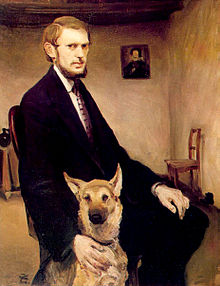
Modern art in Croatia began with the Secession ideas spreading from Vienna and Munich, and post-Impressionism from Paris. Young artists would study the latest trends and integrate them into their own work. Many strove to bring a native cultural identity into their art, for example themes of national history and legends, and some of the artwork following the First World War contained a strong political message against the ruling Austro-Hungarian state. A change was noticeable in 1919 with a move to flatter forms, and signs of cubism and expressionism were evident. In the 1920s, the Earth Group sought to reflect reality and social issues in their art, a movement that also saw the development of naive art. By the 1930s there was a return to more simple, classical styles. Following the Second World War, artists everywhere were searching for meaning and identity, leading to abstract expressionism in the U.S. and art informel in Europe. In the new Yugoslavia, the communist socialist realism style never took hold, but bauhaus ideas led to geometric abstraction in paintings and simplified spaces in architecture. In the 1960s, non-conventional forms of visual expression took hold along with a more analytical approach to art, and a move towards new media, such as photography, video, computer art, performance art and installations, focusing more on the artists' process. Art of the 1970s was more conceptual, figurative and expressionist. However, the 1980s brought a return to more traditional painting and images.
Architecture[]
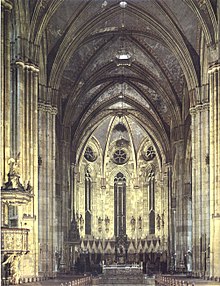
The oldest preserved examples of architecture in Croatia are the 9th century churches, with the largest and the most representative among them being Donatus of Zadar and Church of Holy Trinity, Split.[5][6] Some of the first churches[7] build by the Croats were royal sanctuaries, and the influences of Roman art were the strongest in Dalmatia where urbanization was most dense, and there were the largest number of monuments. Along the coast, the architecture is Mediterranean with a strong influence of renaissance architecture in major urban areas best exemplified in works of Venetian Giorgio da Sebenico and Niccolò di Giovanni Fiorentino. Architecture in Croatia reflects influences of bordering nations. Austrian and Hungarian influence is visible in public spaces and buildings in the north and in the central regions. Large squares named after culture heroes, well-groomed parks, and pedestrian-only zones, are features of these orderly towns and cities, especially where large scale Baroque urban planning took place, for instance in Varaždin and Karlovac.[8][9] Subsequent influence of the Art Nouveau was reflected in contemporary architecture.[10]
Music and Performing arts[]
Music[]
Music in Croatia has two major influences: Central European, present in the central and northern parts of the country including Slavonia, and Mediterranean, particularly present in the coastal regions of Dalmatia and Istria.
In Croatia, both pop and rock are popular, and often incorporates Dalmatian or Slavonian folk elements. Since the mid-20th century, schlagers and chanson-inspired music have formed the backbone of the Croatian popular music.
Theatre[]

Croatian theatre dates back at least as far as the Middle Ages, with a combination of religious liturgical dramas, and secular performances of travelling entertainers. During the Renaissance, there was a flowering of dramatic writing and performances in Dalmatia, especially in Dubrovnik and on the island of Hvar. Notable playwrights of the time were Marin Držić and Hanibal Lucić.[11]
In other parts of Croatia, theatres started to appear in the late 18th, early 19th century in cities such as Split, Dubrovnik, Šibenik, Zadar, Osijek, Varaždin, Pula, Rijeka, and Zagreb. The development of a Croatian National Theatre evolved from Zagreb's first city theatre on St Mark's Square.[12] Beginning in the 1860s, performances were increasingly written and given in Croatian.[13]
Today, Croatia boasts a strong tradition of theatres and theatrical companies all round the country. Performances range from dramas and musicals for adults or children, youth theatre and puppet theatre.[11] Croatia is also home to the world's oldest Theatre of the Blind.[14][15] Festivals are held in several locations in the summer.
Literature[]

Media[]
Cinema[]
Television[]
Television in Croatia was first introduced in 1956. As of 2012 there are 10 nationwide and 21 regional DVB-T (Digital Video Broadcasting – Terrestrial) television channels, and more than 30 other channels either produced in the Republic of Croatia or produced for the Croatian market and broadcast via IPTV (Internet Protocol television), cable or satellite television. The electronic communications market in Croatia is regulated by the Croatian Regulatory Authority for Network Industries (HAKOM), which issues broadcast licenses and monitors the market. The DVB-T and satellite transmission infrastructure is developed and maintained by the state-owned company Odašiljači i veze (OiV).
The first television signal broadcast in Croatia occurred in 1939 during the Zagreb Fair, where Philips showcased its television system. The first regular broadcasts started in 1956, when Television Zagreb was established as the first TV station in the Yugoslav Radio Television system. Color broadcasts began in 1972. Coverage and number of channels grew steadily, and by the 2000s there were four channels with nationwide coverage in Croatia. DVB-T signal broadcasts began in 2002, and in 2010 a full digital switchover was completed. During that period the IPTV, cable and satellite television markets grew considerably, and by 2011 only 60.7 percent of households received DVB-T television only; the remainder were subscribed to IPTV, cable and satellite TV in addition, or as the sole source of TV reception. As of January 2012 DVB-T is broadcast in three multiplexes, while the territory of Croatia is divided into nine main allotment regions and smaller local allotments corresponding to major cities. High-definition television (HDTV) is broadcast only through IPTV, although HDTV DVB-T test programming was broadcast from 2007 to 2011. A DVB-T2 test broadcast was conducted in 2011.
As of November 2019 all national channels are transmitted via three DVB-T and one DVB-T2 (HEVC/H.265) MUXes. After June 2020 DVB-T MUXes will be switched off and all channels will be distributed via two DVB-T2 (HEVC/H.265) MUXes.
Television in Croatia, as all other media in the country are criticised for lack of balance of global issues and trends on one hand and national topics covered on the other. All major television networks in Croatia are generally thought to be under excessive influence of commercialism. State owned Croatian Radiotelevision is required to produce and broadcast educational programmes, documentaries, and programmes aimed at the diaspora and national minorities in Croatia. The television in Croatia is considered to be important in avenue for non-governmental organizations communicating their concerns to the public and to criticising the authorities. Television is the primary source of information for 57% of the population of Croatia.
- Croatian radiotelevision
Radio[]
Croatian Radio (Croatian: Hrvatski radio) is the official broadcasting service of Croatia. Founded on May 15, 1926 as Zagreb Radio, it was the first radio station in Southeast Europe, now part of Croatian Radiotelevision.
The broadcast, which began with just one channel that could be listened to only in Zagreb and northern Croatia, today makes 16 radio channels sent out on short wave, medium wave, FM, satellite and the Internet.[17]
On May 25, 2012, the television and radio program archive and a collection of music production were given the status of Croatia's cultural heritage.[18]
- List of radio stations in Croatia
- List of Croatian language television channels
Education[]

People in Croatia enjoy free government-sponsored education at the primary and secondary level, and partially free university education. There are over 800 primary schools and over 400 secondary schools in the country.
The higher education is also government-sponsored, and mostly free for students who enroll with better results. There are thirty two various polytechnic schools, as well as seven universities in seven larger cities: Zagreb, Split, Rijeka, Osijek, Zadar, Dubrovnik, and Pula. Each of the universities in Croatia is composed of many independent "faculties" (Croatian fakultet, meaning college or department), which focus on specific areas of learning: Natural Sciences, Philosophy, Law, Engineering, Economy, Architecture, Medicine, and so on.
There are also a number of other educational and scientific institutions, such as institutes (most notably the Ruđer Bošković Institute) or the Croatian Academy of Sciences and Arts, a learned society promoting language, culture, and science from its first conception in 1866.
The Roman Catholic Church was instrumental in the founding of many educational facilities in Croatia. The Catholic Church in Croatia continues to maintain numerous seminaries and theological faculties in the country, as well as the Pontifical Croatian College of St. Jerome for Croatian students in Rome.
Places[]
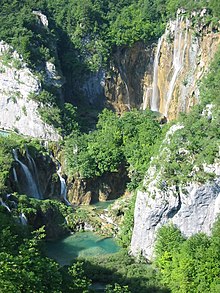
The UNESCO has marked seven places in Croatia as World Heritage Sites:
- Episcopal complex of the Euphrasian Basilica in the historic center of Poreč
- The cathedral of St. James in Šibenik
- Historic city of Trogir
- Diocletian's Palace, built by Roman Emperor Diocletian
- Old city of Dubrovnik
- Plitvice Lakes
- Stari Grad Plain on the Adriatic island of Hvar, parceled by Ancient Greece
Regarding conservation and natural beauty, Croatia has eight national parks, mostly situated along the Adriatic coast.
Festivities and traditions[]
This section is empty. You can help by . (August 2015) |
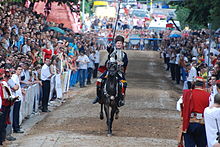
Food and drink[]
Cuisine[]
Croatian cuisine is heterogeneous, and is therefore known as "the cuisine of regions". Its modern roots date back to proto-Slavic and ancient periods and the differences in the selection of foodstuffs and forms of cooking are most notable between those on the mainland and those in coastal regions. Mainland cuisine is more characterized by the earlier proto-Slavic and the more recent contacts with the more famous gastronomic orders of today, Hungarian, Viennese and Turkish, while the coastal region bears the influences of the Greek, Roman and Illyrian, as well as of the later Mediterranean cuisine, including Italian and French.
A large body of books bears witness to the high level of gastronomic culture in Croatia, which in European terms dealt with food in the distant past, such as the Gazophylacium by Belostenec, a Latin-Kajkavian dictionary dating from 1740 that preceded a similar French dictionary. There is also Beletristic literature by Marulić, Hektorović, Držić and other writers, down to the work written by Ivan Bierling in 1813 containing recipes for the preparation of 554 various dishes (translated from the German original), and which is considered to be the first Croatian cookbook.
Wine[]
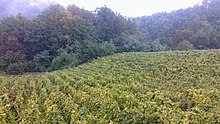
Croatian wine (vino, pl. vina) has a history dating back to the Ancient Greek settlers, and their wine production on the southern Dalmatian islands of Vis, Hvar and Korčula some 2,500 years ago.<[19] Like other old world wine producers, many traditional grape varieties still survive in Croatia, perfectly suited to their local wine hills. Modern wine-production methods have taken over in the larger wineries and EU-style wine regulations [20] have been adopted, guaranteeing the quality of the wine.
There are currently over 300 geographically defined wine regions and a strict classification system to ensure quality and origin. The majority of Croatian wine is white, with most of the remainder being red and only a small percentage being rosé wines. In 2014, Croatia ranked 32nd in wine production by country with an estimated 45,272 tonnes.[21]
Wine is a popular drink in Croatia, and locals traditionally like to drink wine with their meals. Quite often, the wine is diluted with either still or sparkling water—producing a drinks known as gemišt (a combination of white wine and carbonated water) and bevanda (a combination of red wine and still water).
Sports[]
Since independence Croatia has been a fairly successful sporting country. The most popular team sports have been association football (soccer). The Croatian Football Federation (Croatian: Hrvatski nogometni savez), with more than 118,000 registered players, is the largest sporting association in the country.[22]
Other popular sports are handball, basketball and to some extent water polo. The most popular sports played mainly by individuals are tennis, skiing, swimming, and to some extent table tennis and chess. The nation's arenas are primarily used for handball and basketball games.
See also[]
References[]
- ^ "Culture and History". Croatian National Tourist Board. Archived from the original on 16 October 2011. Retrieved 7 October 2011.
- ^ "Roman Art". Artchive.com. Retrieved 15 December 2017.
- ^ Map, The Megalithic Portal and Megalith. "Diocletian's Palace". The Megalithic Portal. Retrieved 15 December 2017.
- ^ Valentin V. Sedov, Slavs in the Early Middle Ages Archived 2013-11-11 at the Wayback Machine
- ^ "CROATIAN ART HISTORY – OVERVIEW OF PREHISTORY". Ministry of Foreign Affairs and European Integration (Croatia). Archived from the original on 7 October 2011. Retrieved 10 October 2011.
- ^ "Church of Saint Donat". Zadar Tourist Board. Retrieved 10 October 2011.
- ^ The First Croatian State Archived 2008-03-31 at the Wayback Machine
- ^ "Varaždin – Baroque Capital of Croatia". Varaždin County Tourist Board. Archived from the original on 12 August 2010. Retrieved 10 October 2011.
- ^ "Najljepši gradovi Sjeverne Hrvatske – Karlovac, Ozalj, Ogulin" [The Most Beautiful Cities of the Northern Croatia – Karlovac, Ozalj, Ogulin]. Jutarnji list (in Croatian). 14 August 2010. Retrieved 10 October 2011.
- ^ Darja Radović Mahečić (2006). "Sekvenca secesije – arhitekt Lav Kalda" [Sequence of the Art Nouveau – Architect Lav Kalda] (PDF). Radovi Instituta za povijest umjetnosti (in Croatian). Institute of Art History (Croatia). 30: 241–264. ISSN 0350-3437. Archived from the original (PDF) on 21 July 2011. Retrieved 10 October 2011.
- ^ Jump up to: a b Hrvoje Ivanković (2007). Susan Jakopec (ed.). "Theatres in Croatia". Croatian Centre of ITI, The International Theatre Institute. Translated by Ivica Zec. Retrieved 21 March 2021.
- ^ "Stankovićevo kazalište" [Stanković's theatre]. Hrvatska enciklopedija, mrežno izdanje (in Croatian). Leksikografski zavod Miroslav Krleža. Retrieved 12 March 2021.
- ^ Cindrić, Pavao (1969). Hrvatsko narodno kazalište: 1894–1969 [Croatian National Theatre: 1894-1969] (in Croatian). Zagreb: Enciklopedijsko izd.
- ^ "Theatre of the Blind and Visually Impaired, New Life: History". Retrieved 19 March 2021.
- ^ Maria Oshodi (2007). "New Life: Blind in Theatre Festival, Croatia 2007". Disability Arts Online, UK. Retrieved 14 March 2021.
With the festival attracting attendance from Spain, Finland, Italy, Poland, Belgium, the US, Slovenia, the UK and Croatia, it has always been a rich mix of experience.
- ^ Žagar, Mateo (1 January 2005). "Grapholinguistic description of Becki listici". Bib.irb.hr. Retrieved 15 December 2017.
- ^ "Općenite informacije o Hrvatskome radiju :: Hrvatski radio". radio.hrt.hr.
- ^ "O HRT-u". Hrvatska radiotelevizija.
- ^ Ante Krstulovic (2008), Vina Hrvatske: Vodeci hrvatski vinari, najbolja hrvatska vina i najvaznije vinske sorte [Wines of Croatia: Leading Croatia Winemakers, Best Croatian Wines and Major Varietals] (in Croatian), Profil, p. 224, ISBN 978-953-12-0944-1
- ^ "Zakon o vinu" [Wine Act] (in Croatian). Narodne novine. 10 June 2003. Retrieved 5 August 2010.
- ^ "Crops processed". FAOSTAT. Food and Agricultural Organization of the United Nations. Archived from the original on May 20, 2011. Retrieved 25 April 2012.
- ^ "About Croatian Football Federation". Croatian Football Federation. Retrieved 6 August 2014.
| Wikimedia Commons has media related to Culture of Croatia. |
External links[]
Heritage - digital collection of Croatian cultural heritage]
- Arts and literature
- Education
- History
- Museum of Croatian Archaeological Monuments home page
- Institute for Ethnology and Folklore
- Lado National Folklore Ansamble
- The History of Necktie
- Nature Protection
- Croatian culture

